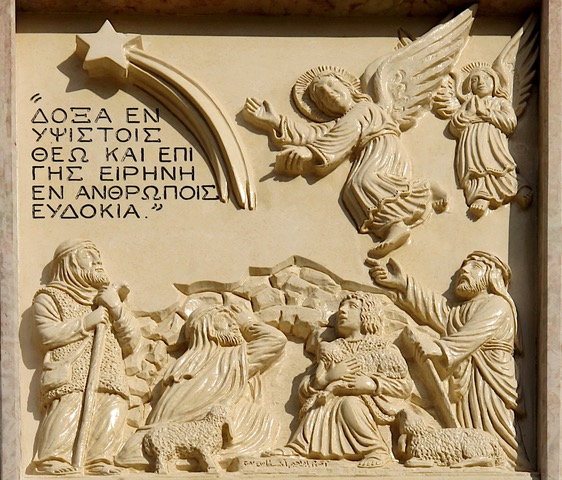Abstract: What would it have been like to be among the shepherds who heard the angelic announcement of Jesus’s birth? Their story has special meaning for many of us because we feel a kinship with those shepherds through shared anonymity and shared hope and witness. By means of two favorite hymns, “Angels We Have Heard on High” and “Far, Far Away on Judea’s Plains,” Kent Jackson invites us to place ourselves in the role of those shepherds and join in singing: “Lord, with the angels we too would rejoice,” and “Come to Bethlehem and see.”
My two favorite Christmas hymns are “Angels We Have Heard on High” and “Far, Far Away on Judea’s Plains.” They have much in common, because both focus on the experience of the shepherds who heard the glorious announcement of the birth of Jesus Christ.
Luke tells us that an angel appeared to the shepherds, announced the holy birth, and told them where they could find the child and how they would recognize him. Then Luke writes, “Suddenly there was with the angel a multitude of the heavenly host praising God, and saying, Glory to God in the highest, and on earth peace, good will toward men” (Luke 2:13–14).
Both “Angels We Have Heard on High” and “Far, Far Away on Judea’s Plains” include those angelic words in their choruses. In our hymnbook the chorus of “Angels We Have Heard on High” is unique because it is the only phrase we sing in sacrament meeting in Latin, the language of the medieval Catholic Church: “Gloria in excelsis deo,” which means, simply, “Glory to God in the highest.” It is also unique in that we stretch the word gloria over four bars and eighteen notes, emphasizing our praise for the wonderful Christmas miracle.
Matthew’s Christmas story introduces us to some upper-tier members of society. The magi, “wise men from the east” (Matthew 2:1), [Page 354]were people who had education. They also had the financial resources to travel far and bring expensive gifts. They were looking for a king, and they ended up in the palace of King Herod in their quest to find him. Then Herod himself wanted to find the new king as well. Matthew’s genealogy of Jesus traces his lineage through the royal line of Judah, connecting Jesus with most of the prominent and privileged people mentioned in the Old Testament.
Luke’s account of the nativity focuses on common people. Jesus is born in a barn among animals to a poor couple far from home. Luke traces Jesus’s genealogy through people who are otherwise unknown, and Jesus’s birth is announced not to those of high standing in society but to the humblest and least regarded of common laboring folk — shepherds. We sometimes romanticize shepherds in the Bible, but shepherding is anything but romantic. Shepherds worked long hours, often alone, and the work was smelly and dirty. Many shepherds didn’t own the sheep they watched but were working for others who were relaxing in their warm homes while the shepherds were shivering with the flocks.
The story of the shepherds in Luke’s account of Jesus’s birth resonates with many of us because we, too, consider ourselves one with people like those. My mother told me from time to time that she was there singing in that heavenly chorus when Jesus was born. Would that we all were so blessed!
“Far, Far Away on Judea’s Plains” is likewise unique in a very important way. All our other Christmas hymns are either of traditional European origin or were composed by American Protestants. But “Far, Far Away” is special. It is a Latter-day Saint hymn. It was written by a Church member named John Macfarlane of the little pioneer settlement in St. George, Utah, in 1869 for a ward Christmas celebration. His family reported that he woke up in the middle of the night with its words and music in his mind and immediately wrote them down. This hymn is ours, and mainstream Christians have not yet discovered it. (On YouTube there are recordings of it by Anabaptist and Mennonite choirs, by choirs of the Church of South India, by immigrant congregations in North America, by a choir as part of a Filipino Catholic mass, and by a bluegrass band!) I hope many more Christians will discover this song because it is a wonderful, energetic hymn of praise and celebration of the coming of Jesus Christ into the world.
[Page 355]

Figure 1. On the wall of the Orthodox Church of the Shepherds near Bethlehem is this modern image of the angel and the shepherds, with the inscription, “Glory to God in the highest, and on earth peace among those with whom he is pleased” (Luke 2:14 ESV).
My wife and I lived in Judea four different times, in three different neighborhoods of Jerusalem. In addition, one summer I lived on a hill overlooking Bethlehem. Let me assure you: there are no plains in Judea; it is very hilly country. Shepherds watch their flocks by night on rocky hillsides, something of which Brother Macfarlane and the unknown translator from the original French of “Angels We Have Heard on High” were not aware. But those songs, despite their topographical imperfections, are perfect gems. They resonate with my heart because their common message is focused on words that belong to all of us: “Come to Bethlehem and see,” and “Lord, with the angels we too would rejoice.”
I want to join in that chorus, to give thanks to our Savior and praises to our Heavenly Father. Indeed, “Gloria in excelsis deo,” “Glory to God in the highest; peace on earth, good will to men!”



Go here to see the 2 thoughts on ““Glory to God in the Highest”” or to comment on it.